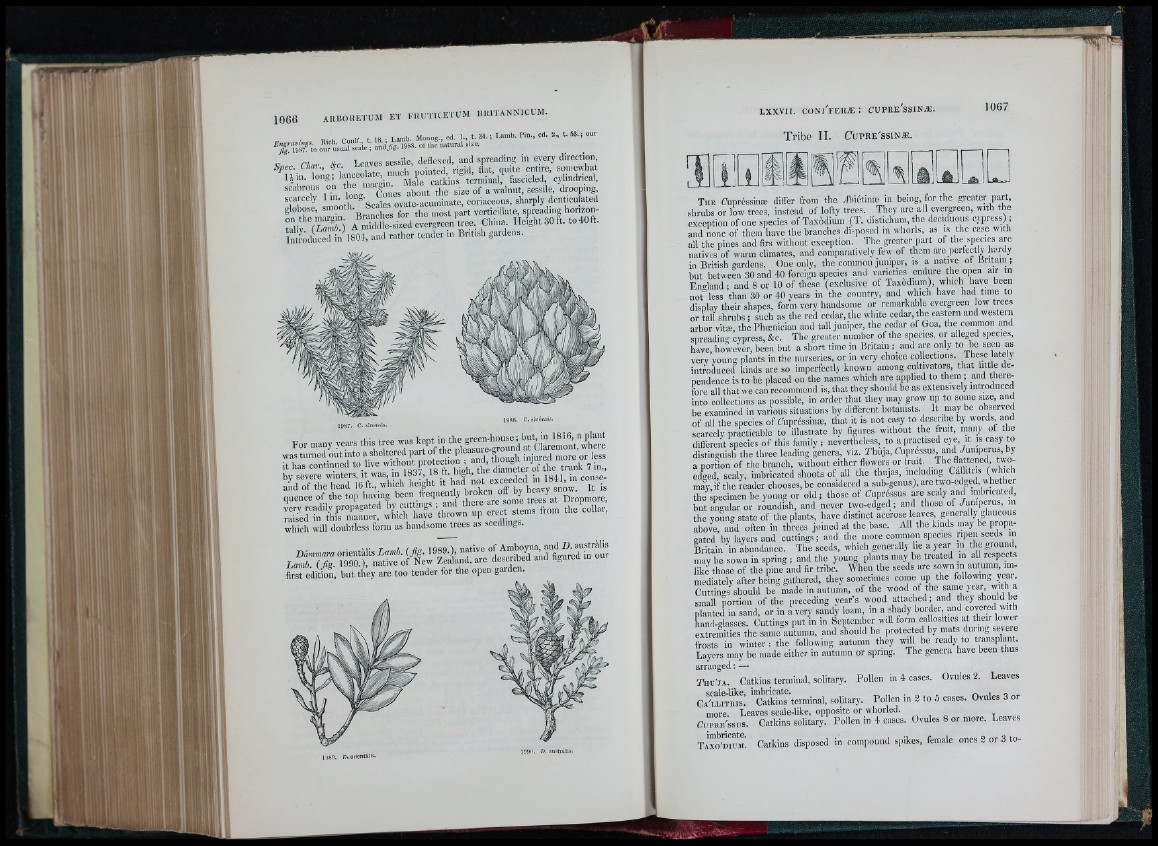
ARBOIIETUM ET FRUTICETUM BIUTANNICUM.
wSteo OOTteutateie*; L?V%“T9l8.ri?rafiaterarsite."‘ '
9 rhnr Ser Leaves sessile, deflexed, and spreading in every direction
T O ? “
globose, smootl • , ^ ^ ^rt verticillate, spreading honzon-
S lY V S r ) A S l “ d ? e rg re e n 'tre e , China Height SO ft. to 40ft.
Inttriluced in 1804, mul rather tender in British galdens.
1987. C. sinensis.
C. sinénsis.
W M m m m s s ;
which will doubtless form as handsome trees as seedlings,
first edition, but they are too tender for the open garden.
1989. 7). orientàlis..
LXXVII. c o n i ' f e r æ : c u p r e ' s s i n æ .
T r i b e I I . C u p r e ' s s i n æ .
1067
T ub Cupréssinæ differ from the Abiétinæ in being, for the greater part,
shrubs or low trees, instead of lofty trees. They are all evergreen, with the
exception of one species of Taxòdium (T. distichum, the deciduous cypress) ;
and none of them have the branches disposed in whorls, as is the case with
all the pines and firs without exception. The greater part of the species are
natives of warm climates, and comparatively few of them are perfect^ hardy
in British gardens. One only, the common juniper, is a native of Britain ;
but between 30 and 40 foreign spedes and varieties endure th® °P®" “
England ; and 8 or 10 of these (exclusive of Taxodium), which have been
not less than 30 or 40 years in the country, and which have had time to
display their shapes, form very handsome or remarkable evergreen low trees
or tall shrubs ; such as the red cedar, the white cedar, the eastern and western
arbor vitæ, the Phcenician and tall juniper, the cedar of faoa, the common and
spreading cypress, &c. The greater number of the species, or alleged species,
have, however, been but a short time in Britain ; and are only to be seen as
very young plants in the nurseries, or in very choice collections. These ately
introduced kinds are so imperfectly known among cultivators, that little dependence
is to be placed on the names which are applied to them ; and theie-
fore all that we can recommend is. that they should be as extensively introduced
into collections as possible, in order that they may grow up to soine size, and
be examined in various situations by different botanists. It may be obseived
of all the species of Cupréssinæ, that it is not easy to describe by words and
scarcely pra tic able to illustrate by figures without the fruit, many of the
different species of this family ; nevertheless, to a practised eye, it is easy to
distinguish the three leading genera, viz Thùja, £!>®®f"®’
a portion of the branch, without either iiowers or frmt- Ttie flattened two-
edged, scaly, imbricated shoots of all the thujas, including Ca litris (which
may, if the reader chooses, be considered a sub-genus), are two-edged, whether
theripecimen be young or old ¡ those of Cupréssus are scaly and imbricated,
but angular or roundish, and never two-edged ; and those of /unfperus, in
the young state of the plants, have distinct acerose eaves generally glaucous
above, and often in threes joined at the base. All the kinds may be propagated
bv layers and cuttings ; and the more common species ripen seeds in
Britain 'in abundance. The seeds, which generally he a year in the ground,
may be sown in spring ; and the young plants may be treated in all lespects
lik J those of the pine and fir tribe. When the seeds are sown in autumn, immediately
after being gathered, they sometimes come up the following year.
Cuttings should be made in autumn, of the wood of the T®»®. »
small ? r t io n o f th e preceding year’s wood attached; and they should be
nlanted in sand, or in a very sandy loam, in a shady border, and covei ed with
hand-"lasses. Cuttings put in in September will form callosities at their lower
extremities the same autumn, and should be protected by “ f® ®®'®ie
frosts in winter : the following autumn they wfl be ready to t anspLmt.
Layers may be made either in autumn or spring. The genera have been thus
arranged ; —
T h u 'j a . Catkins terminal, solitary. Pollen in 4 cases. Ovules 2. Leaves
C aY li tk is .’ Catkins terminal, solitary. Pollen in 2 to 5 cases. Ovules 3 or
more Leaves scale-like, opposite or whorled.
C l w e ' ' s s u s . Catkins solitary. Pollen in 4 cases. Ovules 8 or more. Leaves
TA'??mrM. Catkins disposed in coin|iound spikes, female ones 2 or 3 to